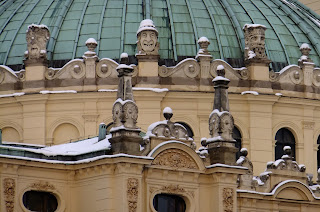Cleaning up the city
There are four models of the city of Hanover in the so called Neues Rathaus, in the main seat of Hanover's municipal authority. They are situated in the huge representative hall of the monumental building of the Rathaus. Employees, customers of the municipality and tourists can enjoy a very good view of the city's most important milestones of urban development, starting with 1689, followed by 1939, 1945 and eventually the modern look of the city.

Hanover's Neues Rathaus
The city models are placed in four corners of the representative hall. Tourist busses stop in front of the city hall and spit out groups of retired Germans, Japanese and Dutch. Their target is the city models.
.JPG)
.JPG)
A gaggle of pensioners gathered around the contemporary Hanover
Accidental visitors and wedding companionships stop there and gaze too:
.JPG)
The four different moments of time have been picked because of their historical meaning to the development of the city. 1689 shows the constituted core of the city - the medieval Hanover on one side of the river Leine and the new baroque part Calenberger Neustadt, on the other side. The second model is capturing Hanover before the war:
City of Hanover, 1939: Just before the beginning of the World War II the city was a flourishing metropolis. All branches of industry boomed. In this time, big concerns who are global players till today established here: Continental, Bahlsen, Hanomag, Pelikan etc. Back then as well, the city was already an important center for industry and trade fairs.
First indicator of the approaching disaster is visible yet in this city model. The synagogue buildng is uniformly gray, marked this way on purpose by the builders of the historical copy of the city to show the visitors where it once stood. 1938, the synagogue disappeared from the city landscape, due to the events of Kristallnacht when it got burnt by Nazis and afterwards demolished. You can see the gray building on this picture, on the extreme right side, in the middle.
The next model shows the city after being bombed by allies and then the fourth is contemporary Hanover.
For the very first time I have seen how the models are being cleaned. Three men were working on the scene: below you can see how one of the men is standing in his socks in the central station. The other guy is vacuum cleaning the contemporary Hanover and the third one is putting the parts which have been removed for the procedure back in place.

I talked to the men and found out that they need two days to clean all of the four models. And they only marginally enjoy the task, they complain about back ache.
The man in the back is carrying around Ernst August Galerie - a big shopping mall next to the central station.
I still think it is a cool job they have, although, I do not envy them about cleaning up the after-war copy of the city. It is a crazy mess:
.JPG)
On the left in the picture, you see the opera. Nowadays back in its glory, see below:
The only building that has not been hit by a bomb: an Art Deco master piece Anzeiger Hochhaus at Steintor - easily recognizable by its green cuppola:
 Nowadays Hanover, seen from the cuppola of the Neues Rathaus including the Anzeiger Hochhaus:
Nowadays Hanover, seen from the cuppola of the Neues Rathaus including the Anzeiger Hochhaus:












.JPG)






























.JPG)
.JPG)
.JPG)



.JPG)


.JPG)